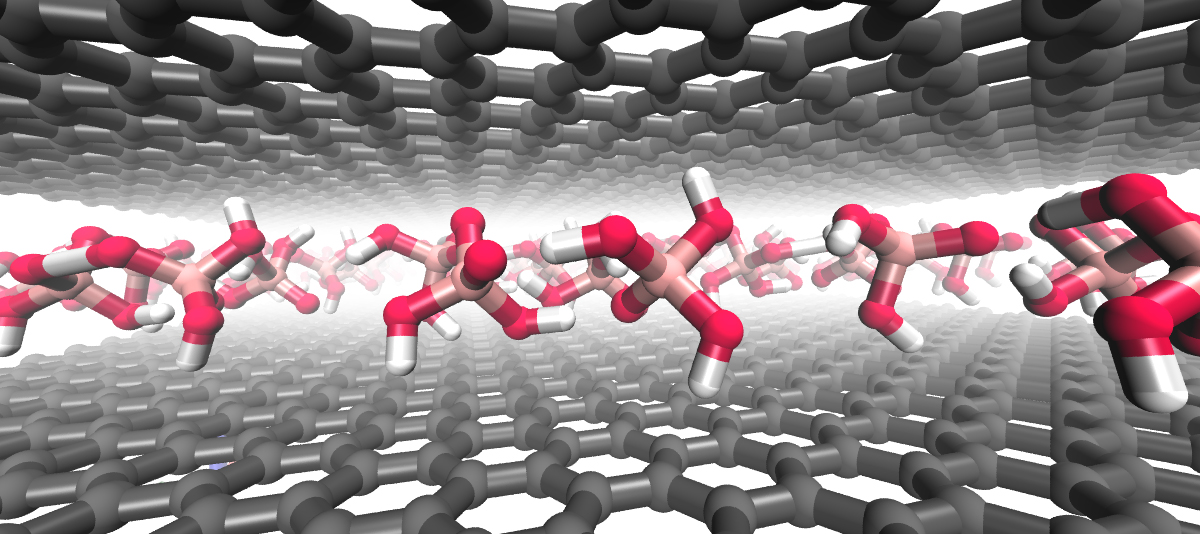Discovery shows route to industrial-scale production of graphene
September 9, 2014

A model of the intercalation of Brønsted acid molecules between single-atomic layers of graphene (credit: Mallouk Lab, Penn State University)
A team of Penn State scientists has discovered a route to making single-layer graphene that has been overlooked for more than 150 years and that makes it easier to ramp up to industrial scale.
Graphene — a tightly bound single layer of carbon atoms with super strength and the ability to conduct heat and electricity better than any other known material — has potential industrial uses that include flexible electronic displays, high-speed computing, stronger wind-turbine blades, and more-efficient solar cells, to name just a few under development.
How to make single or multiple layers of graphene from graphite flakes
(such as from a pencil): University of Manchester researchers show
Physics World reporter James Dacey how to remove layers of graphene
from graphite flakes (using sticky tape), reduce the number of layers,
and then view the graphene under a conventional optical microscope.
(This process is not scalable to make useful sizes or quantities.)
“There are lots of layered materials similar to graphene with interesting properties, but until now we didn’t know how to chemically pull the solids apart to make single sheets without damaging the layers,” said Thomas E. Mallouk, Evan Pugh Professor of Chemistry, Physics, and Biochemistry and Molecular Biology at Penn State.
In a paper first published online on Sept. 9 in the journal Nature Chemistry, Mallouk and colleagues at Penn State and the Research Center for Exotic Nanocarbons at Shinshu University, Japan, describe a new version of a method called intercalation, in which guest molecules or ions are inserted between the carbon layers of graphite to pull the single sheets apart.

Intercalated graphite/1-propanesulfonic particles with a magnified view of the particle edge; (inset) edges of the starting graphite crystal (credit: Nina I. Kovtyukhova et al./Nature Chemistry)
The intercalation of graphite was achieved in 1841, but always with a strong oxidizing or reducing agent that damaged the desirable properties of the material. One of the most widely used methods to intercalate graphite by oxidation was developed in 1999 by Nina Kovtyukhova, a research associate in Mallouk’s lab.
While studying other layered materials, Mallouk asked Kovtyukhova to use her method, which requires a strong oxidizing agent and a mixture of acids, to open up single layers of solid boron nitride, a compound with a structure similar to graphite. To their surprise, she was able to get all of the layers to open up. In subsequent control experiments, Kovtyukhova tried leaving out various agents and found that the oxidizing agent wasn’t necessary for the reaction to take place.
“Single-layer graphene has many possible uses, especially in electronics, and also as a strong but atomically thin membrane,” Mallouk told KurzweilAI in an email. “Our method for the first time enables the preparation of bulk quantities of graphene without chemically damaging the sheets. The work is still in the research stage, and the kinetics of the reaction are slow. If we are successful in speeding up the reaction, then it could have commercial potential.”
Abstract of Nature Chemistry paper
Graphite intercalation compounds are formed by inserting guest molecules or ions between sp2-bonded carbon layers. These compounds are interesting as synthetic metals and as precursors to graphene. For many decades it has been thought that graphite intercalation must involve host–guest charge transfer, resulting in partial oxidation, reduction or covalent modification of the graphene sheets. Here, we revisit this concept and show that graphite can be reversibly intercalated by non-oxidizing Brønsted acids (phosphoric, sulfuric, dichloroacetic and alkylsulfonic acids). The products are mixtures of graphite and first-stage intercalation compounds. X-ray photoelectron and vibrational spectra indicate that the graphene layers are not oxidized or reduced in the intercalation process. These observations are supported by density functional theory calculations, which indicate a dipolar interaction between the guest molecules and the polarizable graphene sheets. The intercalated graphites readily exfoliate in dimethylformamide to give suspensions of crystalline single- and few-layer graphene sheets.